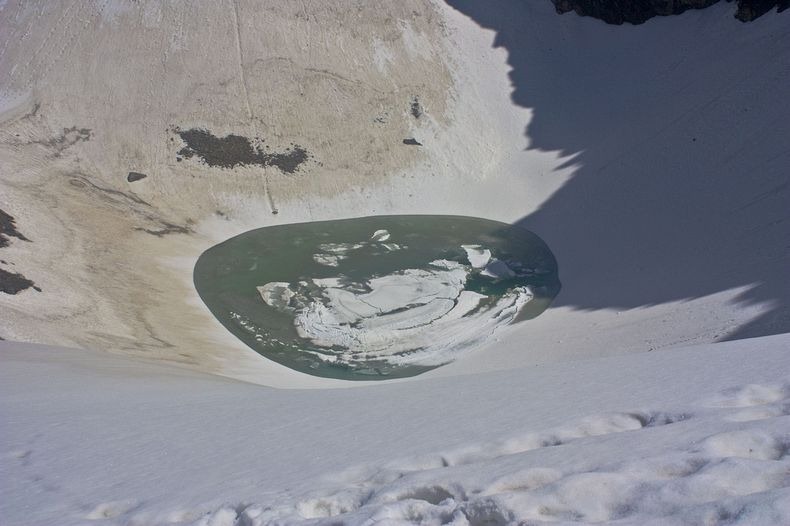Roopkund is a glacial lake located at an altitude of about 5,029 metres in Uttarakhand, a state in India. When the ice melts, hundreds of human skeletons are seen below the surface or floating in the waters.
The lake was first discovered in 1942 by a game reserve ranger, although there are reports about these bones from late 19th century. Initially it was speculated that the remains were those of Japanese soldiers who had sneaked into the area, and then perished to the ravages of the inhospitable terrain. This being the time of World War II, the British immediately sent a team of investigators to determine if they had stumbled upon some secret enemy move. However, upon investigation it was discovered that the corpses couldn’t belong to Japanese soldiers, as they weren’t fresh.
Some British explorers to Roopkund, and many scholars suggested that the bones belonged to General Zorawar Singh of Kashmir, and his men, who are said to have lost their way and perished in the high Himalayas, on their return journey after the Battle of Tibet in 1841. But radio-carbon tests on the corpses in the 1960s belied this theory. The tests vaguely indicated that the skeletons could date back to anytime between the 12th and 15th centuries. This led many historians to link the corpses to an unsuccessful attack by Mohammad Tughlak on the Garhwal Himalaya. Still others believed that the remains were of those of victims of an unknown epidemic. Some anthropologists also put forward a theory of ritual suicide.
It was only in 2004 when a team of European and Indian scientists converged on the area at the behest of the National Geographic Channel, the horrifying truth of the mystery started coming to light.
DNA testing placed the dead into two distinct physical categories - one of short stature and the other significantly taller. Their findings also revealed that the bodies belonged to a much earlier time than previously thought. Carbon dating put the date around 850 AD.
Cracks on the back of their skulls indicated that all of them died by a fatal blow to the back of their head, but they were not caused by a landslide or an avalanche but by blunt, round objects about the size of cricket balls. The absence of injury in any other parts of the body meant that the strike came from above. The only plausible explanation for so many people sustaining such similar injuries at the same time is something that fell from the sky, such as … hailstorm.
There is no historical evidence of any trade routes to Tibet in the area but Roopkund is located on an important pilgrimage route of the Nanda Devi cult with festivities taking place approximately once every 12 years. The group consisting of 500 to 600 people were most likely pilgrims. The primary travellers were all from the same area, and they had hired a group of porters who knew the area to carry their baggage through the high mountains. On coming to the lake, they had probably climbed down the slopes to get fresh water when the clouds moved in. With no shelter in the open Himalayas, many, or possibly all of them, perished. The icy waters preserved their bodies for hundreds of years. Some of them even had hair and nails as well as pieces of clothing intact.
It’s possible that some of the pilgrims escaped the ordeal, returned back to the village and recounted the tale, for there is an interesting folklore. A traditional song among Himalayan women describes a goddess so enraged at outsiders who defiled her mountain sanctuary that she rained death upon them by flinging hailstones “hard as iron”.

via www.roopkund.com




















Not very creative survivalists... I would have thought of a few ways to survive. And yelled for others around to do the same: put something hard over the head, even hands as they can heal, but boots/shoes/luggage/bags are better; lift up shirt/clothing top and hold over the head at a distance so as to at least slow down hail before it hits; hide head under another person's body once they're dead; hide head under a rock's jutting out parts; even let the hail fall on your back instead, or your meaty parts as the latter will recover from the bruises...
ReplyDeleteExcept that hail falls fast and starts quickly - so you'd need SOME reaction time, and you wouldn't get it. When your first warning that something is going on is when everyone get conked on the head at about the same time there's really not much to do.
DeleteIn other words, don't start with the concept that everyone else is a congenital idiot without enough survival skills to cover their heads.
I think I was "hale" corrected by my cell as "hail", as in hailing a cab, right after I pressed "publish". So, correcting my cell here... There. I got the last word in the spelling battle with my stupid smartphone! (Pun intended.)
ReplyDelete"Hail" is the correct spelling :)
ReplyDeleteYour cell stands corrected, but not incorrect.
ReplyDelete